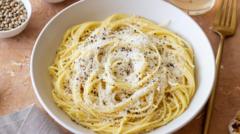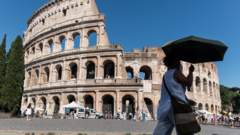Italians are expressing outrage after the UK’s Good Food website posted a recipe for the traditional Roman dish pasta cacio e pepe, incorrectly claiming it could be made quickly and using incorrect ingredients.
Misguided Recipe: Cacio e Pepe Sparks Italian Outrage

Misguided Recipe: Cacio e Pepe Sparks Italian Outrage
A controversial pasta recipe from the UK ignites fury among Italians over cultural misrepresentation.
Italians are incensed after Good Food, a much-followed British culinary site, published a recipe for the traditional Roman pasta cacio e pepe that failed to stick to the authentic ingredients, igniting a wave of indignation across Italy. The website’s suggestion that the dish can be prepared swiftly as "a speedy lunch" drew sharp criticism, as many Italians perceive it as a misunderstood sacred meal rather than just a quick snack.
The recipe in question listed four ingredients—spaghetti, black pepper, parmesan, and butter—while the authentic cacio e pepe requires only three: spaghetti, black pepper, and pecorino cheese. This glaring oversight prompted an Italian restaurant association to formally address the issue with the British embassy in Rome, expressing their astonishment that such an error appeared on a reputable website. Claudio Pica, president of this association, emphasized the importance of preserving the integrity of traditional Italian cuisine, noting that altering cacio e pepe with ingredients like parmesan and butter transforms it into a completely different dish.
Italian media have widely covered the controversy, with opinions shared by chefs and restaurateurs highlighting the deep attachment Italians have to their culinary traditions. Restaurant owner Giorgio Eramo laments the misrepresentation, pointing out that the revised recipe resembles 'pasta Alfredo' rather than the beloved cacio e pepe. He notes the importance of respectful variations that do not wipe away the essence of authentic dishes.
Despite the heated reactions, some, like Eleonora, who works at a café, suggest that while the anger is perhaps excessive, it stems from a deep connection that Italians have with food, which forms an essential part of their culture and identity. With such traditions at stake, misconceptions about Italian cuisine are bound to provoke strong responses. Immediate Media, responsible for the Good Food brand, has yet to respond to requests for comments on the backlash.
The recipe in question listed four ingredients—spaghetti, black pepper, parmesan, and butter—while the authentic cacio e pepe requires only three: spaghetti, black pepper, and pecorino cheese. This glaring oversight prompted an Italian restaurant association to formally address the issue with the British embassy in Rome, expressing their astonishment that such an error appeared on a reputable website. Claudio Pica, president of this association, emphasized the importance of preserving the integrity of traditional Italian cuisine, noting that altering cacio e pepe with ingredients like parmesan and butter transforms it into a completely different dish.
Italian media have widely covered the controversy, with opinions shared by chefs and restaurateurs highlighting the deep attachment Italians have to their culinary traditions. Restaurant owner Giorgio Eramo laments the misrepresentation, pointing out that the revised recipe resembles 'pasta Alfredo' rather than the beloved cacio e pepe. He notes the importance of respectful variations that do not wipe away the essence of authentic dishes.
Despite the heated reactions, some, like Eleonora, who works at a café, suggest that while the anger is perhaps excessive, it stems from a deep connection that Italians have with food, which forms an essential part of their culture and identity. With such traditions at stake, misconceptions about Italian cuisine are bound to provoke strong responses. Immediate Media, responsible for the Good Food brand, has yet to respond to requests for comments on the backlash.




















